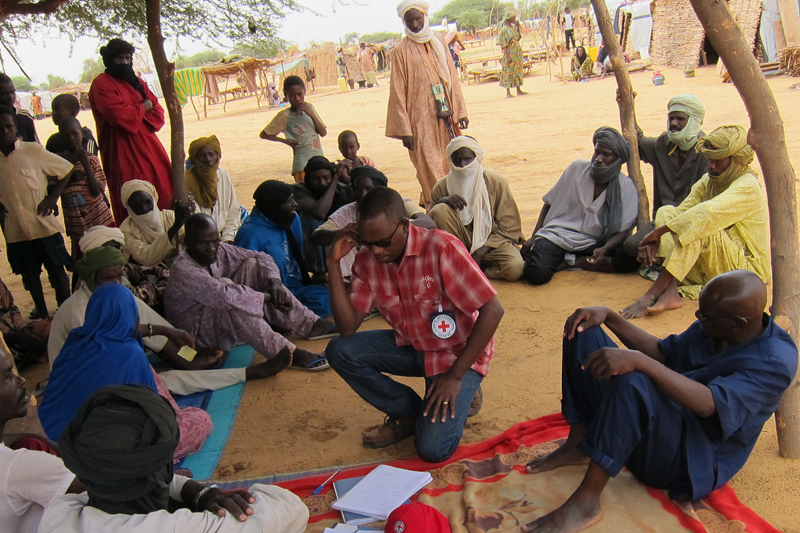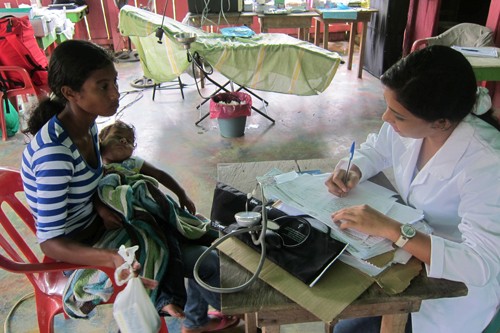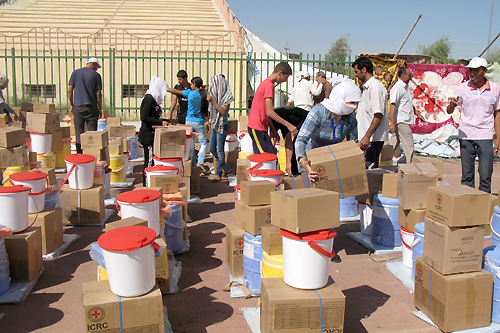Annual report 2013: Operational highlights
14-05-2014 Annual Report
Operational highlights by Pierre Krähenbühl, director of operations.
Conflict environments and challenges for humanitarian action
Several key features emerge on close analysis of the primary characteristics of the armed conflicts and other situations of violence in which the ICRC operated in 2013.
First, with its staggering devastation and regional implications, the conflict in the Syrian Arab Republic (hereafter Syria) developed into one of the most catastrophic and violent crises in a long time. Hundreds of thousands of people were killed or injured, tens of thousands detained or missing, and millions displaced, separated from their families or forced to flee to neighbouring countries and coping with huge pressures. In besieged areas, civilians suffered starvation and lack of access to health care, notably due to the rampant and systematic targeting of medical personnel, transport and facilities. Diplomatic efforts to resolve the crisis continued, but the immediate future looked bleak for Syria’s people.
Second, the instability caused by polarization between States and radicalized armed groups has affected the lives and dignity of countless people, undermined the legitimacy of State institutions and made such situations extremely challenging to resolve. Syria was but one example; in Afghanistan, Mali, Somalia and Yemen, for instance, armed confrontations raised issues linked to indiscriminate acts of violence often affecting mainly civilians, the treatment of detainees and the use of remotely piloted aircraft and other counter-terrorism measures. Governments and the international community have rarely managed to stabilize such situations.
Third, ethnic, nationalist or religious grievances and access to critical resources remained key drivers of protracted armed conflicts and other situations of violence. In the Democratic Republic of the Congo (hereafter DRC), fighting between the army and armed groups, and between several armed groups, occurred alongside heightened intercommunal tensions. Civilians suffered wide spread abuse, including looting, destruction of property, child recruitment and sexual violence. South Sudan suffered armed clashes and intercommunal violence earlier in the year, and then an all-out conflict between military factions, destroying communities and leaving hundreds of thousands displaced, injured or dead.
Fourth, the resurgence of State assertiveness and nationalism raised paradoxes. Weak States tended to generate instability because of their inability to maintain law and order and deliver critical services, while strong States at times undermined respect for State legitimacy by employing repressive means, creating volatility as well. States invoked national sovereignty to prevent outsiders, including humanitarian organizations, from interfering in internal affairs, yet were often not as assertive in assuming their responsibility to deliver key services. State assertiveness rose while critical threats to international security and stability, including “terrorism” and organized crime, became transnational in nature, requiring close international cooperation to resolve.
Fifth, displacement and migration continued to have traumatic consequences for men, women and children. Millions of IDPs in the Central African Republic (hereafter CAR), Colombia, Somalia, Syria and elsewhere suffered multiple displacements, loss of property and livelihoods, physical and sexual abuse and other adversities. Refugees and migrants underwent harrowing ordeals crossing from the Horn of Africa to Yemen, from Libya to Europe, through Central America and across Asia. Particularly tragic were the violations and abuse suffered by migrants caught up in conflict-affected or violence-prone regions where they were often stranded without means of contacting their families.
Finally, despite positive macroeconomic indicators and opportunities generated by broadening access to new information technologies, growing social inequalities persisted, the result of uneven wealth redistribution and the fact that billions still lived in abject poverty.
Operations: Review, approach and thematic challenges
In 2013, the ICRC worked to protect and assist millions of people in armed conflicts and other situations of violence
In 2013, the ICRC worked to protect and assist millions of people in armed conflicts and other situations of violence – men, women and children whose lives and communities were torn apart, their homes and livelihoods destroyed, forced to flee and survive with no access to basic services and suffering the loss, disappearance or injury of loved ones.
It was a year which saw the ICRC step up its response in several high-profile acute crises – from Syria and the surrounding region to the CAR, Mali and South Sudan – and maintain activities in contexts where civilians have for years suffered the heavy consequences of protracted armed conflicts, such as in Afghanistan, Colombia, the DRC, Israel and the occupied territories, and Somalia. It also stepped in when natural disaster struck, coming to the aid, for example, of communities in the Philippines dealing first with the aftermath of Typhoon Bopha and a year later Typhoon Haiyan; the ICRC, which was already working with populations affected by low-intensity conflict, responded to urgent needs with the Philippine Red Cross.
In these and other parts of the world, ICRC teams in the field maintained their proximity to vulnerable populations and gained access to others, sometimes being among the few actors on the ground, as in the CAR, northern Mali or Somalia. This and other key parameters of the ICRC’s working methods, notably its neutral, impartial and independent approach to humanitarian action, confidential dialogue with all sides, and adaptability, enabled it to reach some of the most difficult or isolated areas. In responding to the diverse vulnerabilities of those affected, ICRC teams drew on integrated protection, assistance, prevention and cooperation activities to cover both acute and chronic needs.
ICRC teams in the field maintained their proximity to vulnerable populations and gained access to others, sometimes being among the few actors on the ground, as in the CAR, northern Mali or Somalia.
In many contexts, the ICRC’s approach led to new or reinforced relations with diverse stakeholders – crucial in today’s multipolar world – and therefore acceptance for its mandate and mission; however, the exposure of its staff also led to security risks. In Afghanistan, where the ICRC has been present for many years, an attack on the Jalalabad sub-delegation killed one of the guards, showing that proximity does not always equal acceptance. Increasingly, humanitarian workers faced the threat of abduction, as was the case, at the time of writing, for three ICRC colleagues in Syria. In some contexts the authorities impeded activities, asserting their sovereignty or denying the ICRC access to sensitive places.
In all these operations, cooperation with the National Societies, notably operational partnerships through which thousands of Red Cross or Red Crescent volunteers worked alongside ICRC teams, was a key component of activities for communities. The result was a strong Movement response, for example in Colombia, the DRC, Mexico and Myanmar, that included deployments of National Society medical teams to reinforce ICRC operations, as in the Philippines and South Sudan. National Society volunteers also faced substantial risks, as seen in the critical case of the Syrian Arab Red Crescent, with 33 volunteers killed since the beginning of the conflict (as at 31 December).
Despite the challenges, the ICRC delivered strong responses as set out in its initial budget of CHF 988.7 million for the 2013 Emergency Appeals and in eight budget extensions during the year for the DRC (CHF 10.0 million), Myanmar (CHF 8.1 million), Niamey regional (CHF 39.2 million), the Philippines (CHF 29.7 million and CHF 14.5 million for Typhoons Bopha and Haiyan, respectively), and the Syrian armed conflict (Jordan – CHF 6.4 million; Lebanon – CHF 5.8 million; Syria – CHF 50.1 million).
The different phases of armed conflict and violence – emergency, early recovery and post-conflict – required varied responses. Moreover, people had different needs depending on their gender, age and circumstances (e.g. forcibly displaced, detained or with missing family members). The ICRC, often with National Societies, took these into account in deciding with the populations affected on the most appropriate way to alleviate their suffering, placing their specific needs at the core of the response and drawing on multidisciplinary activities and expertise rather than a standardized approach. In many contexts, it contributed its expertise in particular domains, for example in improving conditions in places of detention through visits and direct assistance to detainees and working with the authorities on a structural level (e.g. Burundi, Cambodia, Madagascar, Lebanon and Zimbabwe). Thanks to sustained efforts and dialogue with authorities, the ICRC obtained greater access to detainees in Bahrain, Ethiopia, Myanmar, Nigeria and Somalia.
Thanks to sustained efforts and dialogue with authorities, the ICRC obtained greater access to detainees in Bahrain, Ethiopia, Myanmar, Nigeria and Somalia.
The ICRC continued to highlight the threats facing health-care service delivery and attacks against health personnel and facilities and patients. It pursued its four-year Health Care in Danger project, with many delegations collecting information on reported incidents and making representations to the alleged perpetrators. Between January 2012 and July 2013, more than 1,400 such incidents were reported in at least 23 countries; over 90% directly affected local health-care providers (private or public), and 14% were related to National Societies. In parallel, workshops and consultations brought together experts, practitioners and armed forces personnel.
Sexual violence was another area in which the ICRC launched a four-year plan, in 2013, to strengthen its holistic operational response to the thousands of women, girls, men and boys affected in armed conflicts and other situations of violence, with devastating consequences.
Profound changes within the humanitarian community made coordination and partnership as important as ever. With so many players responding in crises – the Movement, UN agencies, regional bodies, armed forces, governments, national and international NGOs, faith-based organizations, donors, and other actors increasingly seen on the front line – ICRC field teams stepped up their efforts to coordinate activities and share analyses.
Africa

Agoudoufoga, northern Tillabéry, Niger. An ICRC delegate phones the relative of a refugee who has remained in Mali, to enable them to exchange news. © ICRC / L. Mamoudou / v-p-ne-e-00089
Acute crises in the CAR, the DRC, Mali and South Sudan unfolded alongside persistent poles of instability and humanitarian needs, including in Libya, Nigeria, Somalia and Sudan.
In Mali, following conflict and division in 2012, a military intervention led by France and Mali and several other African nations in early 2013 led to the retaking of the country’s northern regions. Despite improvements for the population, insecurity prevailed, displaced persons did not return in great numbers and significant needs remained. ICRC support helped ensure the full functioning of the Gao hospital and several clinics, where people received emergency or standard health services. Over half a million people also benefited from food distributions or agricultural projects. Dialogue with the Malian government and the French armed forces facilitated ICRC access to detainees.
The multiplicity of armed groups in different parts of the DRC affected millions of people, who suffered attacks, looting, sexual abuse, displacement, injury or death. The arrival of the “intervention brigade” under a more robust UN mandate and operations carried out by the DRC armed forces led to the military defeat of the M23. Working closely with the National Society, the ICRC focused its response on emergency medical needs, providing surgical support in hospitals in Goma during peaks of conflict. IDPs and returnees received critical assistance, and victims of sexual violence obtained psychological support and medical treatment at ICRC-supported counselling centres.
In the neighbouring CAR, after the overthrow of the government in March, nine months of sectarian violence killed thousands, displaced even more and undermined already weak State service delivery. Thanks to its longstanding presence in Bangui and in towns like Kaga Bandoro or Ndele, the ICRC was able to pr e-serve its access and implement vital activities, from an emergency medical response alongside Médecins Sans Frontières, to food, water and livelihood projects that helped IDPs and residents boost their coping ability – although, overall, the security situation on the ground presented some challenges in reaching all those in need.
South Sudan ended the year in the midst of an armed conflict between rival military factions, coming on top of several instances of intercommunal violence throughout the year, notably in Jonglei state. The remoteness of the regions affected and the fragility of national institutions prompted the ICRC to significantly scale up its capacities, centring on medical aid, food and water provision and protection activities.
In northern Nigeria, violence occurred among communities and between government forces and Boko Haram. With its office in Maiduguri, the ICRC was among the few organizations addressing some of the population’s priority needs, together with the National Society.
In Sudan, operations continued in Darfur; they did not develop in Blue Nile and South Kordofan.
Asia

Philippines, Lawa-an. Clean drinking water is distributed by tanker. Water treatment units and distribution systems have been set up in seven municipalities for more than 40,000 people living along the coast.© ICRC
South Asia experienced the lingering consequences of armed conflict and violence. In Afghanistan, the prolonged suffering of the population seemed set to continue. The deadly attacks against the Jalalabad sub-delegation and National Society and NGO staff were evidence of the challenging environment. Partly revising its setup, the ICRC continued its operations – its second-largest worldwide – maintaining support for hospitals, National Society clinics and physical rehabilitation centres. It visited people detained, predominantly by the Afghan authorities but also by the remaining international forces.
In Pakistan, following the killing of an ICRC medical delegate in 2012 as well as discussions with the authorities, operations were limited to those outlined in a 1994 agreement, leaving the ICRC’s activities reduced in this context.
The impact of the ICRC’s response in Myanmar grew considerably in 2013. In Rakhine state, it worked with health authorities and the National Society in providing civilians with health care and other assistance following intercommunal violence. It resumed visits to detainees and delivered medical supplies to Kachin state. It also started carrying out training for Myanmar police forces.
The Philippines was twice in twelve months hit by deadly typhoons. Together with the Philippine Red Cross, the International Federation and other National Societies, the ICRC deployed additional personnel and provided food, shelter, medicine and water for hard-hit communities in Mindanao and, later, in Samar. During the year, violence in Zamboanga required emergency action for tens of thousands of IDPs.
Europe and the Amercias

Colombia, Village of El Dorado.The ICRC and health-care staff from the local authority in Montecristo and the Department of Bolívar braved the unpaved trails to provide over 1,600 medical services and consultations in the temporary health unit. © CICR / L. Gómez / v-p-co-e-02476
Operations in Latin America focused on the needs of people affected by the conflict in Colombia. Despite the ongoing peace negotiations, the effects of years of conflict remained; the ICRC, often with the Colombian Red Cross, responded to urgent and long-term needs relating, inter alia, to medical assistance in remote areas, weapon contamination and the consequences of sexual violence. Acting as a neutral intermediary, the ICRC facilitated the release of 26 people held by armed groups, enabling them to return to their families, in some cases after many years.
Across the Americas and Europe, with the National Societies, the ICRC addressed consequences of conflicts or violence on communities – as in Chile, Peru and the South Caucasus – and migrants – as in Central America, Greece and Italy. This included responding to needs in relation to disappearance, health care, sexual violence, conditions of deportation and severed family links. The issue of missing persons remained a priority in the South Caucasus and the Western Balkans.
Across the region, the ICRC visited people deprived of their freedom, including at the US internment facility at Guantanamo Bay Naval Station in Cuba, where over 160 people have received almost a hundred visits since 2002. It called for the transfer of internees already declared eligible and for improved family contacts for inmates. In Uzbekistan, the ICRC terminated its visits to detainees owing to its inability to work according to its standard procedures.
Middle East

Iraq, Bardarash. Syrian refugees help ICRC staff organize basic hygiene and household items for distribution to 763 people. © ICRC / iq-e-01163
In Syria, despite numerous operational constraints, up to 200 ICRC staff, together with the Syrian Arab Red Crescent, reached hundreds of thousands of people affected by the conflict. The ICRC stepped up its presence in early 2013, opening a base in Tartus, thereby broadening its contacts with all parties and obtaining greater access across fighting lines. With the Syrian Arab Red Crescent, it distributed food and household kits to millions of people, mainly IDPs also benefiting from emergency drinking water and improvements to their housing. An estimated 80% of the population continued drinking water thanks to ICRC-donated water-treatment supplies, spare parts, pumps and generators to local water boards.
Of deep concern to the ICRC in Syria was the obstruction of its medical activities, severely constrained by widespread insecurity and the authorities’ unwillingness to let medical supplies enter areas held by armed groups. There was likewise no progress on access to detainees, whose conditions and treatment were worrying.
In neighbouring Iraq, Jordan and Lebanon, the ICRC, with the National Societies, provided emergency medical assistance, food, essential household items, clean water and/or family-links services for people fleeing Syria.
Inside Iraq, the situation further deteriorated, with levels of violence and casualties at their highest since 2006–07 and the sectarian nature of the confrontations becoming a source of concern. The ICRC continued visiting detainees and implementing large-scale medical and livelihood programmes for people displaced or otherwise vulnerable.
In Israel and the occupied Palestinian territory, the ICRC visited prisoners and helped Palestinians living under occupation meet their essential needs through various initiatives. In the Gaza Strip, for example, it rehabilitated key water and health infrastructure in coordination with the de facto authorities. It also began to engage in a constructive debate with the Israeli public on three occupation policies, namely the routing of the West Bank barrier, the annexation of East Jerusalem and the settlement policy, which contravene IHL. For other issues such as the conduct of hostilities, detention and the restoration of family links, the ICRC maintained bilateral and confidential dialogue with the Israeli authorities. In Yemen, armed clashes continued, affecting civilian life and injuring or killing many, even as the National Dialogue Conference was ongoing. During fighting in Dammaj village, the ICRC evacuated wounded people in risky cross-line operations. While security and access issues affected certain activities, it provided emergency relief, medical support and livelihood assistance for IDPs and residents, and reached an agreement with the government, awaiting formalization, on improved access to detainees.
